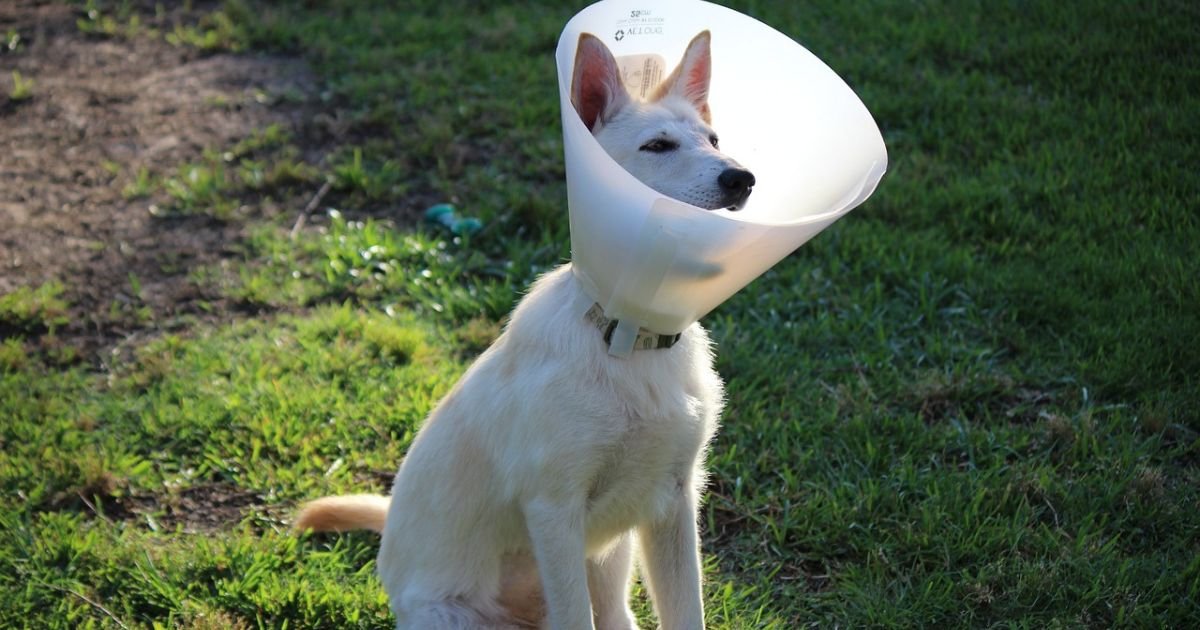Choosing between inflatable and cone dog collars seems like a war especially when our canine companions undergo surgery or sustain injuries. Their instinct to lick or chew at the affected area can impede healing.
To safeguard against this, veterinarians often recommend the use of protective devices. The traditional Elizabethan cone, commonly known as the “cone of shame,” is a widely recognized solution.
It forms a barrier around the dog’s head, preventing them from reaching their wounds. While effective, its cumbersome design can cause distress and hinder daily activities.
Resembling a travel pillow, an inflatable dog collar restricts access to injuries while allowing for a more natural range of motion.
Dogs can eat, sleep, and navigate their environment with relative ease, making the recovery process less stressful for both pets and owners.
The choice between an inflatable collar and a traditional cone is a common dilemma faced by pet owners. It’s a decision that weighs the pros and cons of each option in terms of comfort, convenience, and the nature of the dog’s injury or surgical site.
Some dogs may tolerate a cone without issue, while others might find an inflatable collar to be a more humane and equally effective option.
In this article, we’ll delve into the specifics of each device, comparing their features and discussing how to choose the best option for your furry friend’s recovery.
Understanding the Traditional Cone
The traditional cone, often referred to as the Elizabethan collar or “E-collar,” is a staple in post-operative care for dogs.
Its design, reminiscent of the ruffs worn during the Elizabethan era, serves a crucial function in the healing process of our furry friends.
Cones are essential in preventing dogs from licking or biting at their wounds or surgical sites. Acting as a physical barrier, they extend beyond the dog’s muzzle, ensuring that the affected areas are kept safe from the dog’s instinct to lick or chew at irritations.
This protection is vital for preventing infection and ensuring that stitches or wounds heal properly.
Despite their protective benefits, cones are not without drawbacks. They can significantly restrict a dog’s peripheral vision and hearing, leading to disorientation and confusion.
Additionally, the rigid structure of the cone can cause discomfort, and its size may obstruct visibility, making everyday activities like eating and sleeping challenging.
In some cases, prolonged wear can lead to skin irritation or damage to the dog’s coat, especially in long-haired breeds.
The Rise of Inflatable Dog Collars
Inflatable dog collars represent a significant advancement in pet care, especially for those recovering from surgery or injury. These collars are gaining popularity as a more humane and comfortable alternative to the traditional cone.
An inflatable dog collar is a soft, adjustable, and air-filled collar that provides a cushioned barrier around a dog’s neck.
Made from materials like PVC or nylon, these collars are designed to be lightweight and comfortable, preventing dogs from reaching their wounds without the added discomfort of a hard cone.
They are typically used during a dog’s recovery period to prevent them from licking or biting at stitches or injuries.
The advantages of inflatable dog collars over traditional cones are numerous. Firstly, they offer greater comfort, as they do not rub against the dog’s neck or restrict movement as much as rigid cones do.
They also allow for better visibility, as they do not block the dog’s peripheral view, reducing stress and confusion.
Additionally, inflatable collars do not interfere with a dog’s ability to eat or drink, making it easier for them to maintain normal daily activities.
Dogs can also sleep more comfortably with an inflatable collar, which can improve their overall recovery experience.

Comparison Between Inflatable Dog Collars and Traditional Cones
Choosing the right protective gear for a dog’s recovery is crucial. This section provides a detailed comparison between inflatable dog collars and traditional cones, focusing on protection, comfort, and practicality.
Protection Level
The primary purpose of both the inflatable collar and the cone is to protect a dog’s wound or surgery site from interference.
Traditional cones offer a high level of protection due to their restrictive design, which covers the entire head and neck area.
Inflatable collars, while more comfortable, may offer slightly less restriction and protection, especially if the wound is on the lower part of the body or the dog is particularly flexible.
Dog’s Tolerance and Comfort
Comfort is a significant factor in a dog’s recovery. Inflatable collars are generally more tolerated by dogs as they do not impact visibility or interfere with eating and sleeping.
Cones, however, can cause distress due to reduced visibility and mobility, leading to a more stressful recovery period.
Practicality for Owners
For pet owners, the ease of maintenance is an important consideration. Inflatable collars are often preferred for their durability and ease of cleaning.
They are also less likely to be removed by the dog compared to cones, which can be cumbersome and more challenging to keep clean.
Choosing the Right Option for Your Dog
Selecting the appropriate recovery aid for your dog is a decision that should be tailored to their specific needs and overall well-being.
This section will guide you through the process of evaluating your dog’s unique situation and the importance of professional veterinary advice.
Assessing Your Dog’s Needs
To determine the best option for your dog, consider the location and nature of their injury or surgical site, their size, breed, and flexibility.
For instance, an inflatable collar may be suitable for injuries on the upper body, while a traditional cone might be necessary for lower body wounds.
Additionally, assess your dog’s temperament and activity level; a more active dog might require a sturdier option like a cone to ensure protection.
It’s also important to consider the duration of recovery and whether the protective device will be needed short-term or for an extended period.
Veterinarian’s Advice
A veterinarian’s guidance is invaluable in making the right choice for your dog’s recovery.
Vets can provide insights based on a thorough assessment of your dog’s health condition, including a physical examination and review of their medical history.
They can also suggest adjustments to the chosen device for a better fit and increased effectiveness.
Following your vet’s instructions is crucial for a safe and speedy recovery, and they can help you navigate any concerns or complications that may arise during the healing process.
Final Thoughts
In the journey of recovery for our canine friends, the choice between an inflatable dog collar and a traditional cone is more than a matter of preference—it’s a decision that impacts their comfort and healing. We’ve explored the traditional cone’s protective nature and its potential drawbacks, such as discomfort and restricted visibility. The inflatable collar, on the other hand, offers a softer, more flexible alternative that can ease the stress of recovery for both dogs and their owners.
Ultimately, the best choice depends on the individual dog’s needs, the location of their injury, and their overall behavior and temperament. Consulting with a veterinarian is paramount to ensure that the selected device provides adequate protection without compromising the dog’s well-being. By considering these factors and seeking professional advice, pet owners can make an informed decision that prioritizes the health and happiness of their loyal companions during a vulnerable time.

